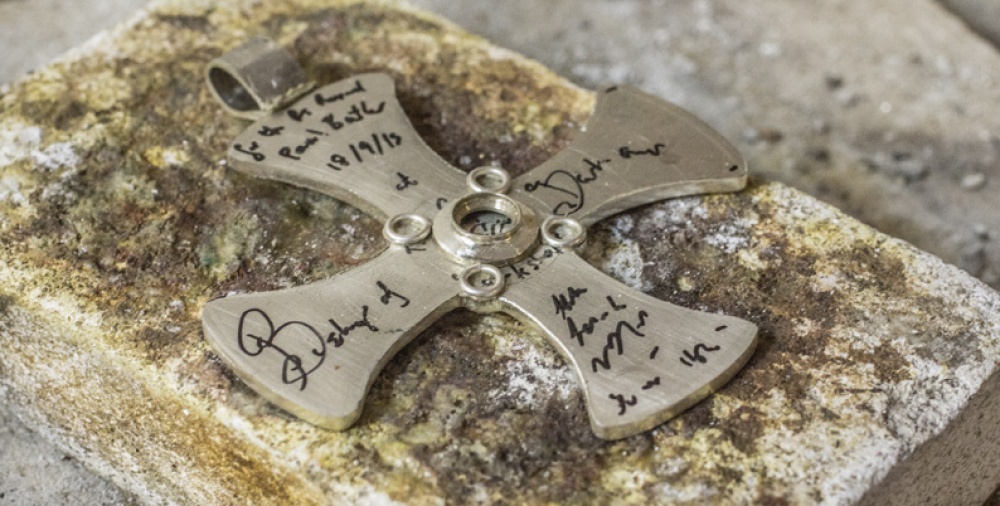Meet The Maker - Andrew Ashcroft

We spoke to Durham goldsmith Andrew Ashcroft
How did you get into making jewellery, where did you learn your trade?
I always had an interest in jewellery because my dad was an antiques dealer, but actually getting into the trade was a little bit of a fluke. I was going to go to university but I got a summer job at a local jeweller who had an Australian Goldsmith. I saw what he did, loved it, and convinced him to take me on as an apprentice. I was with him for nearly five years. Once he had to go back to Australia I decided to set out on my own.
Did you have any formal training?
I learned a lot from him, and since then I’ve done courses at various places around the country that do more specialised training. University training for becoming a goldsmith is virtually non-existent. There are a lot of courses in jewellery design but it’s much more to do with design than all the technical details, an apprenticeship is pretty much the only way. It’s just years at the bench learning the old-fashioned way.
What was it that appealed about working with jewellery?
For me it’s a perfect mix of everything that I’m interested in because I’m a very technically-minded person; I’m really interested in learning all the intricate, complicated processes to create something. At the same time I’m a creative person, I’ve always liked to draw and paint.
Do you always work to commission?
More than 95 percent of what I do is specific to commission. Within that it varies as to how much is my design and how much is the customer’s concept – most of the inspiration tends to come from the customer. The process I enjoy the most is that conversation with the customer, trying to get out of them exactly what they want, as opposed to trying to push my creative ideas on them. Beyond that I do take a lot of inspiration from the local area; I’m quite a keen amateur photographer so I do a lot of photography of local flowers and wildlife, and even some more abstract stuff. I’m always looking and seeing patterns and getting concepts, it’s about a general awareness.
What kind of materials do you use and where do you get them from?
I use any precious metals and gemstones, so silver, platinum, palladium and various different gold alloys. Palladium is a similar metal to platinum but it’s not as expensive, most people aren’t aware of it because it’s difficult to mass produce, so you tend not to see it on the high street, but it’s a lovely precious metal. I get some scrap in from the public that I recycle and there’s a couple of larger bullion dealers I get any other material from.
What makes your work stand out?
I think the biggest thing that makes my jewellery different from the high street is that it has input from each customer. Although there may be some general themes within the designs, each one of them is personal to a client rather than just being my design. It’s important to me, it keeps me interested and it keeps the designs changing over the years so I don’t get stuck in a rut doing the same thing.
Are there any pieces you’ve made that you’re particularly proud of?
The pectoral cross is obviously something that I’m particularly proud of because it’s something that’s very special for Durham and the area, it’s not often you get the opportunity to do that type of work. A couple of years ago I had a guy who was missing a hand and had been given a generic hook and false arm. He wanted a ‘dress hook’ for special occasions, a traditional-looking engraved silver hook which was great because it was totally unique and a good challenge technically because I had to have all the right steel fittings to connect to his false arm.
How did you come to design the Bishop of Durham’s pectoral cross?
I was approached by the Bishop’s wife Rosemary. She came in with some ideas and we discussed it for a long time. It was for his 60th birthday at the end of September but he also needed a proper pectoral cross – he’s relatively new to the job and she wanted to get him something nice to wear. She wanted to keep it fairly traditional, in the end we went for a design which was inspired by some of the columns in the main hall of the cathedral.
Did you face any particular challenges designing the cross?
The main thing was getting that balance of something traditional but unique, something that would stand the test of time and wouldn’t be offensive to the eye in 10 years’ time. In terms of actual challenges, making it wasn’t out of the scope of things I’ve done in the past, so it wasn’t too difficult in that sense.
Where do you see yourself in five years’ time?
I’d like to still be here, I’m pretty sure I will be. I have an apprentice and I would like her to reach a point where she can do more work herself. I haven’t got big plans to expand the business, I’d just like to still be getting the opportunity to make unusual and unique things.







